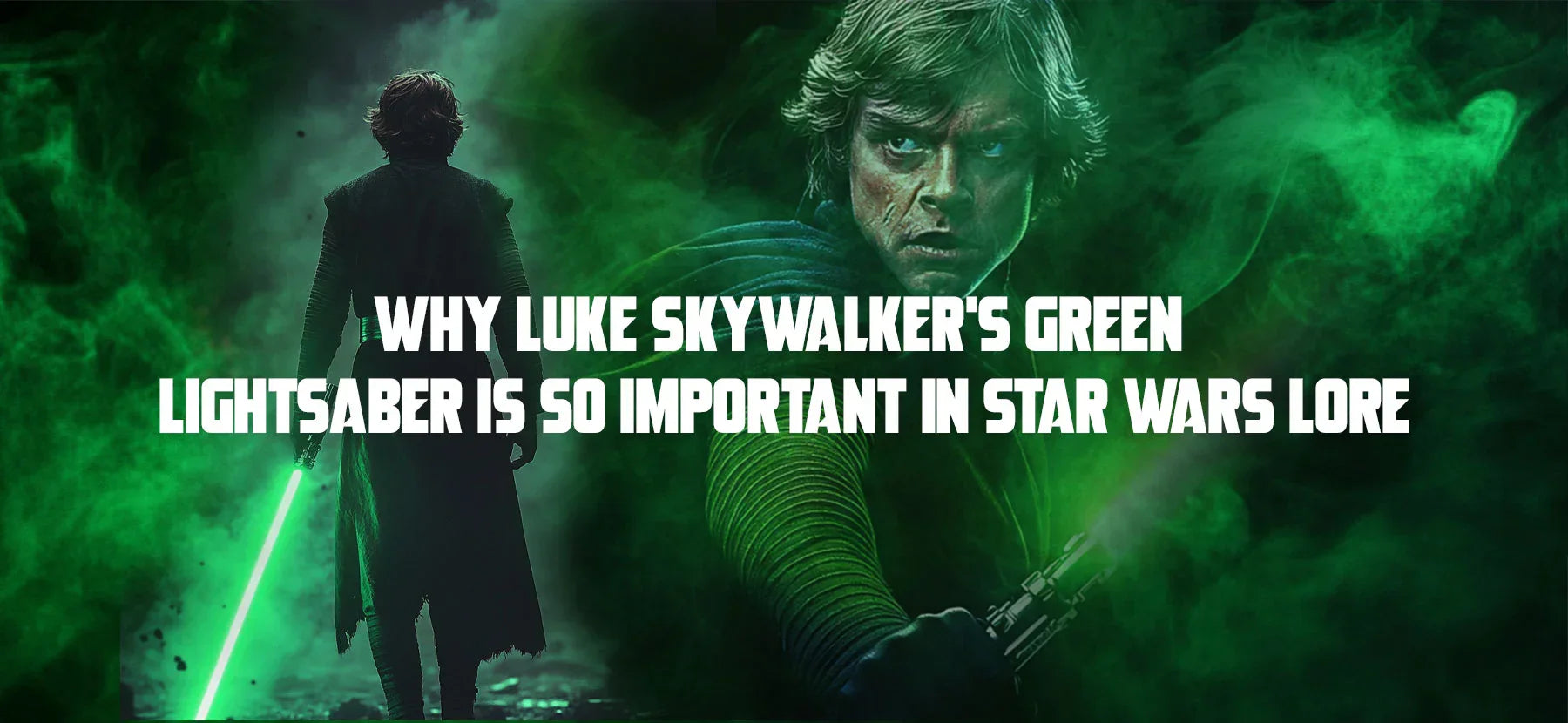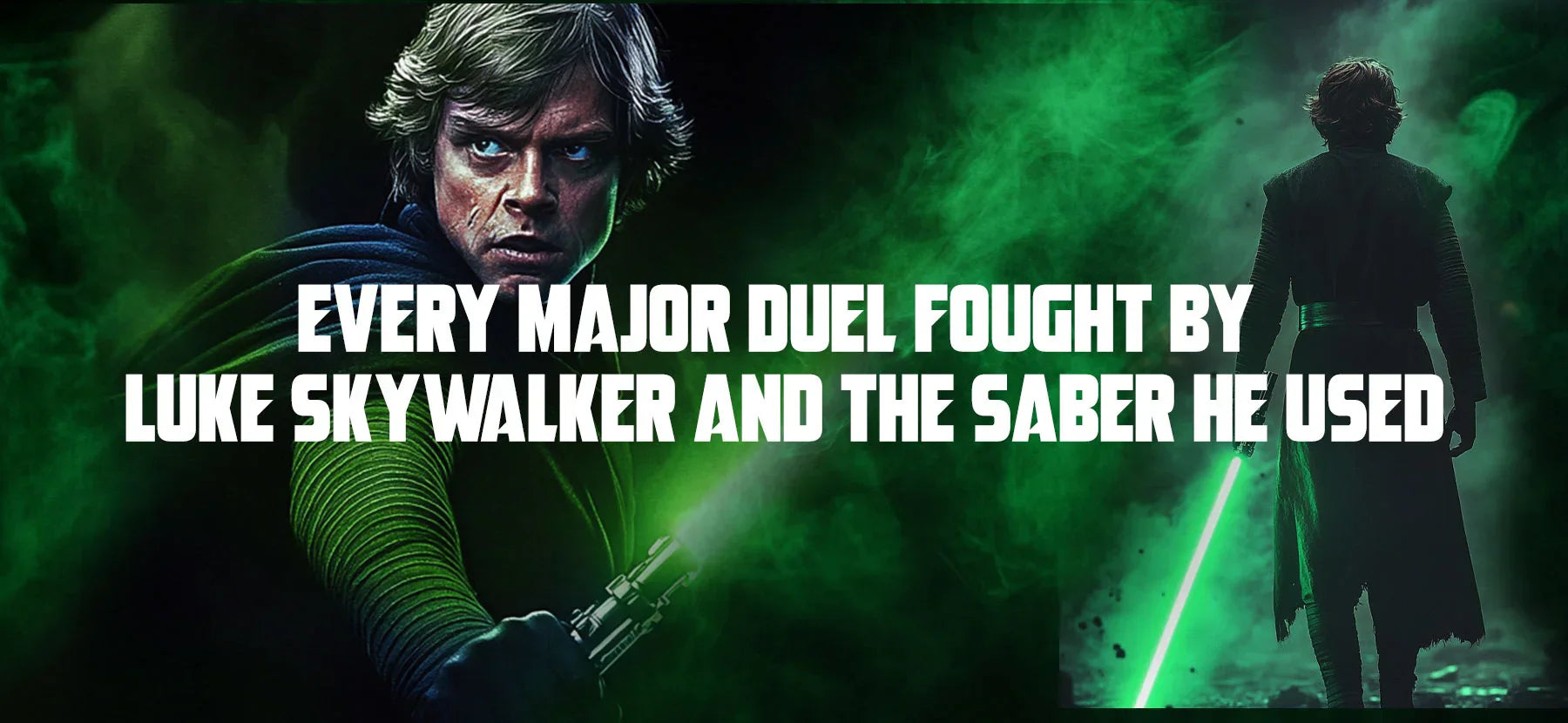One of the most well-known Jedi in Star Wars history, Luke Skywalker, created his own lightsaber fighting approach. Integrating inherited techniques, personal improvisation, and Force knowledge. Though Luke's path lacked the methodical Jedi training of the prequel era, his fighting style drew considerably from Form V (Djem So). It is often associated with Anakin Skywalker's style. Luke grew past his father's teachings over time, showing great adaptability in duels against Darth Vader and Kylo Ren. His lightsaber fighting matched his increasing Force control. Enabling him to confront dangers few Jedi could not resist.
Chapter 1: Form V: Luke’s Foundation and Connection to Anakin

Form V, notably the Djem, forms the foundation of Luke Skywalker's lightsaber fighting philosophy. Djem: So variant, it is a discipline of strength, precision, and strong counterattack. It is a demanding variant. Luke's fighting style shows Anakin's influence both literally and figuratively. He never officially trained under the Jedi Order as his father did, yet the connection remains clear.
Features of Form V (Djem So)
Unlike purely defensive forms like Form III (Soresu), which prioritizes evasion and deflection, Djem So seeks to turn defence into attack. Practitioners are taught to intercept enemy strikes and then launch strong ripostes. These are designed to shatter their opponent’s defence and put them on the defensive.
Form V is all about this never-ending cycle of taking blows and retaliating with tremendous strength. Djem So depends on effective power punches and powerful, purposeful overhead swings. The aim is not to overwhelm opponents with speed but to control the pace of combat. It dominates through precision and strength.
Unlike the extremely acrobatic Form IV (Ataru), which uses flips, spins, and quick moves, Djem So keeps its practitioners grounded. This ensures every blow has maximum force. A rooted posture gives leverage and stability.
This strategy was ideal for Luke's situation. He had to invent a combat technique that was flexible and practical. It had to be effective even in the worst of conditions.
Inherited Echoes of Anakin's Style
Though Luke never directly observed Anakin's fighting technique, his skill in Form V reflects his father's method in several respects. Luke and Anakin both preferred straight confrontations, fronting their foes rather than using evasive strategies. Both showed the same dependence on power-driven methods. Each employed intentional, accurate strikes to rule battles and retain command of the fight.
The father and son shared a deep connection to the Force. It helped them sharpen their abilities. It also helped them anticipate enemies’ attacks and counter with surprising speed and reflexes. But one fact could not be undermined: both of them, Luke and Anakin, were fundamentally different.
Anakin's readings of Djem So were dark, while Luke represented calm and restraint. In comparison to Anakin, Luke was mindful enough to ignore the negative calls. He remained loyal to the Jedi Council and avoided falling to fury by employing the same force that drove his father into the dark side.
The Return of the Jedi made this clear when Luke fought Vader in a one-on-one battle. Luke intentionally stayed off the dark side.
Symbolism of the Inherited Blade
Metaphorically related to the lightsaber Luke wields, Form V is also related. He has a blue lightsaber for Anakin. As both Jedi Knight and Sith Lord, he used the same weapon his father once brandished. By means of djem So mastery, Luke gets both a weapon and a martial philosophy passed down over centuries.
Building his own green lightsaber before facing Vader again in Return of the Jedi shows his growth beyond imitation. Although his base is still Djem So, Luke's greater grasp of the Jedi path enables him to temper the raw violence of the style. He balances it with restraint, patience, and defensive awareness.
Luke converts a form formerly defined by antagonism into one that reflects his compassion and individual growth. This balance of inherited talent and restraint sets his position among Star Wars mythology’s most powerful Jedi.
Chapter 2: The Fight at Cloud City

Luke Skywalker was new and knew little about the Jedi style of fighting. This was clear in The Empire Strikes Back during his first fight with Darth Vader on Cloud City.
Luke relied mostly on impulse and basic Djem as he entered the fight. He had only brief instructions from Obi-Wan Kenobi and Yoda. Vader could easily react to his predictable, unvaried attacks with countermoves. Using little energy, Vader ruled the early exchanges. He forced Luke onto the defensive, testing his stamina.
Luke surprised himself when he hit Vader's shoulder. His innate talent and growing Force sensitivity were visible. But Vader dominated him both physically and mentally. He caught Luke off guard and slashed his right hand off completely.
This battle draws attention to Luke's enormous capacity as well as his unevolved simplicity.
Duel in the Throne Room (Return of the Jedi)
Luke's progress as both a duelist and a Jedi was clear by this point. Once more in the Emperor's throne room on board the second Death Star, he challenged Vader. His new green lightsaber showed his developing understanding of Jedi teachings as well as his growing freedom.
Their fight showed Luke's improved technique and emotional control. Unlike their meeting on Cloud City. Luke’s use of the Djem So technique in this fight was much more refined. He used exact counters to divert Vader's blows. He struck back with calculated attacks, matching his father's strength blow for blow.
Luke stayed calm through most of the battle. He resisted anger and fear even as Vader provoked him. Vader threatened to convert him to the dark side. Luke temporarily lost his restraint. He launched a furious series of attacks.
Djem So's philosophy of strength and direct attack was perfectly reflected in his aggressive, forceful blows. At the height of their battle, Luke completely mastered Vader, disarming him and pausing for the conclusion.
Reaching the peak of his power, Luke chose a different path. Instead of obeying Emperor Palpatine, he rejected the dark side and reclaimed his identity as a true Jedi.
Fighting Kylo Ren
On the planet, Luke and his nephew, Kylo Ren, had one of Star Wars' most famous battles in Crait. Rather than depending on physical power or lightsaber ability, Luke used the Force to project himself. He appeared younger and carried his father's recovered blue lightsaber.
This illusion let him face Kylo without really being present, showing his incredible command of the Force. Luke focused on evasion and perfect defence throughout the battle, avoiding every direct hit. Driven by fury, Kylo launched an unrelenting assault. Yet Luke dodged every strike without attacking back once.
The conflict bought time for the remaining Resistance members to escape. It served a greater purpose than just defeating Kylo in battle.
This moment marked the pinnacle of Luke's Jedi philosophy. No longer defined by the aggression of Form V, he rose above physical fighting. For Luke, victory now meant maintaining hope, protecting life, and showing the true meaning of Jedi discipline.
By confronting Kylo without violence, Luke affirmed the Order's principles. He stood as a beacon of peace, even in his final act.
Chapter 3: Evolution of Luke’s Technique Over the Years

Luke Skywalker's lightsaber skills changed greatly throughout his life. They were shaped by his unusual training, real combat experience, and a gradual philosophical transformation. His path was unconventional, unlike the Jedi of the Old Republic who received years of organised training within the Temple.
Initial Coaching Phase
When Luke first started his trip, he was mostly self-taught. His first method of lightsaber combat was basic and intuitive, having had little exposure to Jedi literature and only Obi-Wan Kenobi's support. Inclining naturally toward Form V's tenets, he favoured powerful, attacking strokes meant to overpower opponents.
However, his underdeveloped training showed. His method lacked nuance. His first confrontation with Darth Vader on Cloud City exposed this ignorance. Even while Luke displayed remarkable courage and innate ability, he was evidently outmatched. His determination and force awareness suggested the duelist he would eventually be.
Return of the Jedi
By the time Return of the Jedi arrived, Luke's style had changed immensely. A symbolic turning point in his development was creating his own green-bladed lightsaber. It showed his deeper knowledge of Jedi customs and his growing independence.
Using Djem So, his aggressive counters became more powerful. His foundations grew stronger, and he began incorporating more controlled defensive responses. Compared to his younger self, Luke’s quick movements, precise blade control, and ability to shift smoothly between offence and defence stood out.
This maturity was clear in the throne-room battle with Vader. He maintained emotional control while matching his father’s force. Luke showed restraint, unlike Anakin's impulsive nature. He defeated Vader without giving in to rage.
Post-Original Trilogy Increase
After the fall of the Empire, Luke improved his training by studying lost traditions and ancient Jedi writings. Though Djem So remained his base, he began blending aspects from other forms. He incorporated Soresu's patience and Ataru's agility to produce a hybrid design suited to his evolving worldview.
The events of The Last Jedi revealed the full scope of Luke's knowledge. His perspective changed. Originally, he viewed his lightsaber only as a weapon, but now it represented Jedi principles.
Rather than depending only on strength, he concentrated on strengthening his link to the Force. Simple, intentional, and strategic became his style. His projected battle against Kylo Ren on Crait, where he embodied ultimate Jedi discipline, resulted from this. Luke overcame without ever hitting once.
Chapter 4: Force Synergy and Lightsaber: Luke's True Might

Though Luke Skywalker's lightsaber abilities are very remarkable, his primary strength is how naturally he combines the Force into his fighting style. Many Old Republic Jedi saw the lightsaber and the Force as distinct instruments. Luke, on the other hand, finds a seldom-seen equilibrium between the two.
For him, the lightsaber is an extension of his link to the Force. Rather as a separate weapon, it lets him move, react, and fight as one with it. Luke's sharp integration with the Force is shown by his improved reflexes and vision, which go above physical restrictions.
Instead of depending only on speed or strength, he uses the Force to sense approaching danger. He often senses Vader's intentions a moment before they appear. This makes counterattacks possible, exactly timed and almost flawless parries. That awareness enables him to maintain his position against adversaries of significantly more natural strength, such as Darth Vader.
Luke benefits from reacting methodically rather than on impulse during their fights. Luke's innate attunement to the Force is just as crucial in his battle against Kylo Ren. Without expending energy, it enables him to feel his adversary's emotional state and regulate the course of the battle.
Luke gently enhances his physical prowess by means of the Force. He employs it in battle to boost speed, endurance, and strength. This lets him execute the form V-characteristic hard, decisive blows without wearing as fast as an untrained combatant.
This balance of power and conservation helps him remain calm and centred while still pressuring his opponents. Luke never abuses this ability. He channels only enough Force to improve his technique, not to overpower his enemies. This reflects his evolution and self-control as a Jedi.
This synergy at its height is seen in Luke's last fight on Crait in The Last Jedi. By his cosmic projection, he converts what appears like a physical fight with Kylo Ren into a symbolic show of rebellion and optimism.
He postpones the First Order and guarantees the survival of the Resistance without one blow. Luke exemplifies the Jedi ideal by means of his flawless combination of lightsaber skill and Force mastery.
His real power resides in rising above the need for violence rather than in defeating adversaries by means of brute strength. He shows that the Jedi's strongest weapon is the Force when combined with skill and intention.
FAQS
Luke uses the force in his lightsaber combat?
Luke adds strength, stamina, and improved accuracy by using the Force, hence combining knowledge with strategy. He also awaits strikes.
Luke's battle against Kylo Ren in The Last Jedi shows his skill in what way?
Luke shows great Jedi discipline and the height of his lightsaber Force integration by projecting himself throughout the universe; hence, he wins without blood.
Luke Skywalker's lightsaber technique changes over time?
Beginning with basic, self-taught abilities, Luke gradually sharpens his approach with defensive moves and forced-assisted reflexes till he perfects a balanced, minimalist style by The Last Jedi.
How do Luke's battle tactics differ from those of Darth Vader?
Either prefer Form V, Luke transforms the form into a more balanced, defensive stance, while Vader uses raw strength and threat.




Leave a comment
This site is protected by hCaptcha and the hCaptcha Privacy Policy and Terms of Service apply.